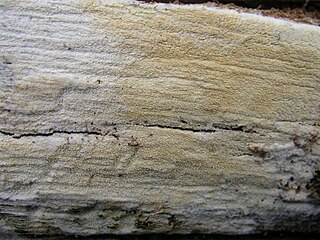
Agaricomycetidae is a subclass of fungi, in the division Basidiomycota. The name Agaricomycetidae had previously been named by Marcel Locquin in 1984, but his publication did not contain a Latin diagnosis and it is therefore invalid under the International Code of Nomenclature for algae, fungi, and plants. It was subsequently validly published by Erast Parmasto in 1986.
Phanerochaete carnosa is a species of crust fungus in the family Phanerochaetaceae. It is a plant pathogen that infects plane trees. The fungus was first described to science by Edward Angus Burt in 1926 as a species of Peniophora. It was transferred to the genus Phanerochaete by Erast Parmasto in 1967.

The Steccherinaceae are a family of about 200 species of fungi in the order Polyporales. It includes crust-like, toothed, and poroid species that cause a white rot in dead wood.

Erast Parmasto was a noted Estonian mycologist, bioscientist and botanist and onetime director of the Estonian Institute of Zoology and Botany.
The Estonian Institute of Zoology and Botany (ZBI) was a zoological and botanical research institute based in Tartu, Estonia. It was founded in 1947. Since 1997, it belonged to the Estonian University of Life Sciences as a central biological research institute in the country. On January 1, 2005 it was merged into the Institute of Agricultural and Environmental Sciences.

The Botryobasidiaceae are a family of fungi in the order Cantharellales. The family contains a group of corticioid fungi that form thin, web-like basidiocarps. Some species form asexual anamorphs producing chlamydospores. All are believed to be wood-rotting or litter-rotting saprotrophs. None is known to be of any economic importance.

Auriporia is a small genus of four species of poroid fungi in the family Fomitopsidaceae.

Byssomerulius is a widely distributed genus of crust fungi.

Scytinostromella is a genus of crust fungi in the Stereaceae family. The widespread genus contains five species. The genus was circumscribed by Estonian mycologist Erast Parmasto in 1968, who set Peniophora heterogenea as the type species. Characteristic features of the genus include dimitic hyphae, spores that are both amyloid and asperulate, and the presence of cystidia and rhizomorphic strands.
Gloeohypochnicium is a genus of wood-inhabiting crust fungi of uncertain familial placement in the order Russulales. Originally conceived by Erast Parmasto as a subgenus of Hypochnicium, Kurt Hjortstam considered it worthy of distinct generic status in 1987. The type species, G. analogum, was described as new to science in 1913 by French mycologists Hubert Bourdot and Amédée Galzin as a species of Gloeocystidium. G. versatum was added to the genus in 2010.

Hydnophlebia is a genus of five species of toothed crust fungi in the family Meruliaceae. All species are wood-decay fungi that cause a white rot.

Dentocorticium is a genus of six species of poroid fungi in the family Polyporaceae. The genus was revised in 2018, with several new species added and some older species transferred to other genera, based on phylogenetic analyses.

Fibrodontia is a genus of fungi in the Hydnodontaceae family. The widely distributed genus was circumscribed by Erast Parmasto in 1968. According to Index Fungorum, the type species Fibrodontia gossypina is currently known as Hyphodontia gossypina (Parmasto) Hjortstam.
The following lists events that happened during 2012 in Estonia.

Liiva-Putla Nature Reserve is a nature reserve situated on Saaremaa island in western Estonia, in Saare County.
Leucogyrophana pseudomollusca is a fungus of the genus Leucogyrophana and family Hygrophoropsidaceae. It was originally described by Estonian mycologist Erast Parmasto in 1962 as a species of Merulius. He transferred it to Leucogyrophana in 1967.

Byssomerulius corium is a common species of crust fungus in the family Irpicaceae. The fungus was first described as Thelephora corium by Christiaan Hendrik Persoon in 1801. Erast Parmasto made it the type species of his newly circumscribed genus Byssomerulius in 1967.
Lilaceophlebia is a genus of three species of crust fungi in the family Meruliaceae. The genus was first proposed by Erast Parmasto in 1968 as a section of the genus Phlebia. Viacheslav Spirin and Ivan Zmitrovich elevated the taxon to generic status in 2004.
Acanthophysellum is a genus of fungus belonging to the family Stereaceae.

Odonticium is a genus of fungi belonging to the family Rickenellaceae.











